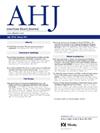脉冲场消融相关的血红蛋白尿和急性肾损伤:有效管理的见解和策略。
IF 3.5
2区 医学
Q1 CARDIAC & CARDIOVASCULAR SYSTEMS
引用次数: 0
摘要
脉冲场消融已成为心房颤动消融的新技术,与传统的热能消融方法相比,具有心肌优先消融和安全性优势。并发症如溶血、血红蛋白尿和急性肾损伤已被报道,特别是高能量输送和过量应用。虽然短暂性和亚临床溶血很常见,但大规模的登记数据表明,临床上显著的溶血引起的肾脏并发症仍然很少见,只有不到0.05%的患者需要干预。然而,了解潜在的机制和预防策略,并确定高危人群,对于优化程序安全性和确保一致的结果非常重要。我们探索了导致这些问题的机制、发生率、临床生物标志物和危险因素的当前数据。这篇叙述性综述提供了一个基于证据的框架和实用策略、个体患者评估和术后管理,以解决和支持将脉冲场消融更安全地整合到临床实践中。随着导管设计和技术的不断发展,进一步的长期数据研究对于继续更好地理解和标准化缓解策略至关重要。本文章由计算机程序翻译,如有差异,请以英文原文为准。

Pulsed field ablation-related hemoglobinuria and acute kidney injury: Insights and strategies for effective management
Background
Pulsed field ablation has emerged as a novel technique for atrial fibrillation ablation, offering myocardial preferential ablation and safety advantages over traditional thermal energy methods. Complications such as hemolysis, hemoglobinuria, and acute kidney injury have been reported, particularly with high-energy delivery and excessive applications.
Objective
To understand the underlying mechanisms and potential preventative strategies, and identifying at-risk populations, to optimize procedural safety and ensure consistent outcomes.
Methods
This narrative review explores current data on mechanisms, incidence, clinical biomarkers, and risk factors that contribute to these issues.
Results
While transient and subclinical hemolysis is common, large scale registry data demonstrate that clinically significant hemolysis-induced renal complications remain rare, with fewer than 0.05% of patients requiring intervention. As catheter design and technology continue to evolve, further research with long-term data is crucial to continue to better understand and standardize mitigation strategies.
Conclusion
This paper provides an evidence-based framework and practical strategies, individual patient assessment, and postprocedural management to address and support safer integration of pulsed field ablation into clinical practice.
求助全文
通过发布文献求助,成功后即可免费获取论文全文。
去求助
来源期刊

American heart journal
医学-心血管系统
CiteScore
8.20
自引率
2.10%
发文量
214
审稿时长
38 days
期刊介绍:
The American Heart Journal will consider for publication suitable articles on topics pertaining to the broad discipline of cardiovascular disease. Our goal is to provide the reader primary investigation, scholarly review, and opinion concerning the practice of cardiovascular medicine. We especially encourage submission of 3 types of reports that are not frequently seen in cardiovascular journals: negative clinical studies, reports on study designs, and studies involving the organization of medical care. The Journal does not accept individual case reports or original articles involving bench laboratory or animal research.
 求助内容:
求助内容: 应助结果提醒方式:
应助结果提醒方式:


